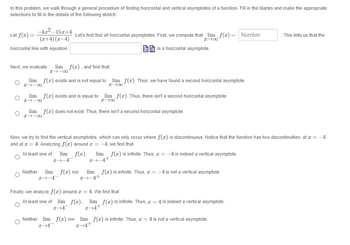
Calculus: Early Transcendentals
8th Edition
ISBN: 9781285741550
Author: James Stewart
Publisher: Cengage Learning
expand_more
expand_more
format_list_bulleted
Question

Transcribed Image Text:In this problem, we walk through a general procedure of finding horizontal and vertical asymptotes of a function. Fill in the blanks and make the appropriate
selections to fill in the details of the following sketch.
Let f(x) =
-4z²-15z+4
(x+4)(x-4)
horizontal line with equation
Let's first find all horizontal asymptotes. First, we compute that_lim_ f(z) = Number
I→∞
is a horizontal asymptote.
Next, we evaluate lim f(x), and find that:
I→→∞0
lim f(z) exists and is not equal to
I→→∞
lim f(x) exists and is equal to
I→→∞0
∞--I
lim f(z). Thus, we have found a second horizontal asymptote.
I→∞
lim f(z). Thus, there isn't a second horizontal asymptote.
I→∞
lim f(z) does not exist. Thus, there isn't a second horizontal asymptote.
Now, we try to find the vertical asymptotes, which can only occur where f(z) is discontinuous. Notice that the function has two discontinuities, at x = -4
and at z = 4. Analyzing f(z) around + = -4, we find that
At least one of lim f(z), lim f(z) is infinite. Thus, z = -4 is indeed a vertical asymptote.
I→→4
2+-4+
Neither lim f(z) nor lim f(z) is infinite. Thus, z = -4 is not a vertical asymptote.
z+-4+
I→-4-
Finally, we analyze f(x) around = 4. We find that
At least one of lim_ f(z), lim f(z) is infinite. Thus, z = 4 is indeed a vertical asymptote.
I-4
2+4+
This tells us that the
Neither lim f(z) nor lim f(z) is infinite. Thus, z = 4 is not a vertical asymptote.
I-4
2+4+
Expert Solution
arrow_forward
Step 1: Define the problem
The given function is
Step by stepSolved in 6 steps with 20 images

Knowledge Booster
Similar questions
- Show your work pleasearrow_forward10. Given f(x) = Domain of f(x):_ Range of f(x): List all asymptotes of each type. If it does not exist, write None. Horizontal: 3 x x²-x-2 List x-intercept(s). List y-intercept(s). CHART Vertical: Graph the function. Label all asymptotes and intercepts. Set up a chart with domain and range values for points plotted. 6arrow_forwardFor the function graphed above, determine eacharrow_forward
arrow_back_ios
arrow_forward_ios
Recommended textbooks for you
 Calculus: Early TranscendentalsCalculusISBN:9781285741550Author:James StewartPublisher:Cengage Learning
Calculus: Early TranscendentalsCalculusISBN:9781285741550Author:James StewartPublisher:Cengage Learning Thomas' Calculus (14th Edition)CalculusISBN:9780134438986Author:Joel R. Hass, Christopher E. Heil, Maurice D. WeirPublisher:PEARSON
Thomas' Calculus (14th Edition)CalculusISBN:9780134438986Author:Joel R. Hass, Christopher E. Heil, Maurice D. WeirPublisher:PEARSON Calculus: Early Transcendentals (3rd Edition)CalculusISBN:9780134763644Author:William L. Briggs, Lyle Cochran, Bernard Gillett, Eric SchulzPublisher:PEARSON
Calculus: Early Transcendentals (3rd Edition)CalculusISBN:9780134763644Author:William L. Briggs, Lyle Cochran, Bernard Gillett, Eric SchulzPublisher:PEARSON Calculus: Early TranscendentalsCalculusISBN:9781319050740Author:Jon Rogawski, Colin Adams, Robert FranzosaPublisher:W. H. Freeman
Calculus: Early TranscendentalsCalculusISBN:9781319050740Author:Jon Rogawski, Colin Adams, Robert FranzosaPublisher:W. H. Freeman
 Calculus: Early Transcendental FunctionsCalculusISBN:9781337552516Author:Ron Larson, Bruce H. EdwardsPublisher:Cengage Learning
Calculus: Early Transcendental FunctionsCalculusISBN:9781337552516Author:Ron Larson, Bruce H. EdwardsPublisher:Cengage Learning

Calculus: Early Transcendentals
Calculus
ISBN:9781285741550
Author:James Stewart
Publisher:Cengage Learning

Thomas' Calculus (14th Edition)
Calculus
ISBN:9780134438986
Author:Joel R. Hass, Christopher E. Heil, Maurice D. Weir
Publisher:PEARSON

Calculus: Early Transcendentals (3rd Edition)
Calculus
ISBN:9780134763644
Author:William L. Briggs, Lyle Cochran, Bernard Gillett, Eric Schulz
Publisher:PEARSON

Calculus: Early Transcendentals
Calculus
ISBN:9781319050740
Author:Jon Rogawski, Colin Adams, Robert Franzosa
Publisher:W. H. Freeman


Calculus: Early Transcendental Functions
Calculus
ISBN:9781337552516
Author:Ron Larson, Bruce H. Edwards
Publisher:Cengage Learning